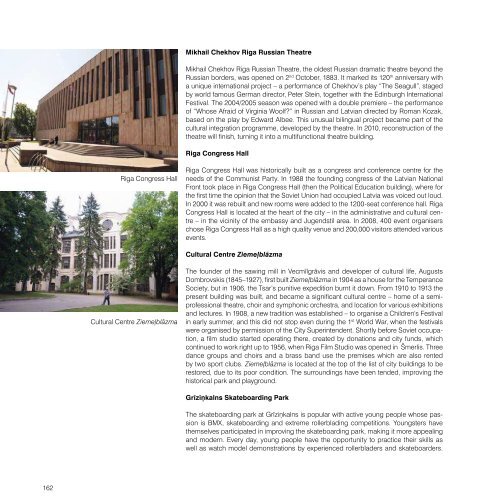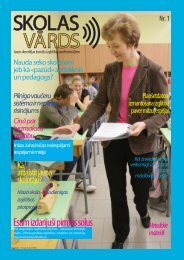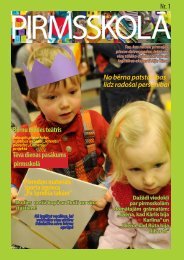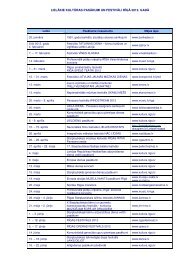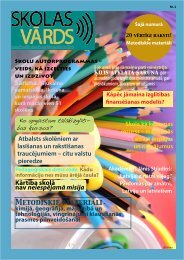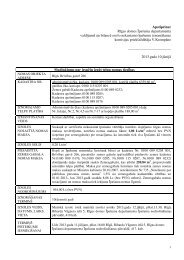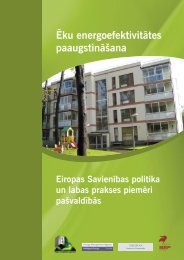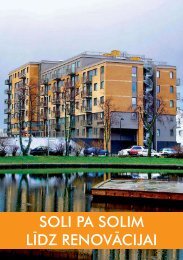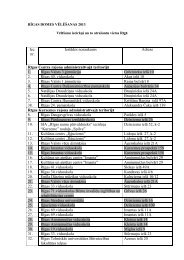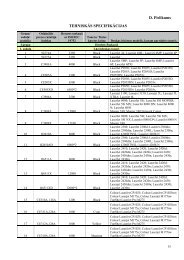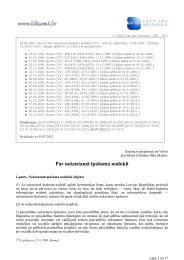Riga - European Capital of Culture 2014 candidate
Riga - European Capital of Culture 2014 candidate
Riga - European Capital of Culture 2014 candidate
- No tags were found...
You also want an ePaper? Increase the reach of your titles
YUMPU automatically turns print PDFs into web optimized ePapers that Google loves.
Mikhail Chekhov <strong>Riga</strong> Russian TheatreMikhail Chekhov <strong>Riga</strong> Russian Theatre, the oldest Russian dramatic theatre beyond theRussian borders, was opened on 2 nd October, 1883. It marked its 120 th anniversary witha unique international project – a performance <strong>of</strong> Chekhov’s play “The Seagull”, stagedby world famous German director, Peter Stein, together with the Edinburgh InternationalFestival. The 2004/2005 season was opened with a double premiere – the performance<strong>of</strong> “Whose Afraid <strong>of</strong> Virginia Woolf?” in Russian and Latvian directed by Roman Kozak,based on the play by Edward Albee. This unusual bilingual project became part <strong>of</strong> thecultural integration programme, developed by the theatre. In 2010, reconstruction <strong>of</strong> thetheatre will finish, turning it into a multifunctional theatre building.Streetball competitions are also organised in the park, as well as dance and rappercompetitions and other street culture campaigns.Station SquareStation Square is crossed by thousands <strong>of</strong> people every day, crossing it on the way fromthe station past the department stores and on to the city centre, and back again in theevening. For over several years now Station Square has become a successful locationfor the International Baltic Ballet Festival activities, bringing classical and contemporarydance art closer to the city dweller. Similarly, other cultural activities frequently take placein the square.<strong>Riga</strong> Congress HallGalerija Centrs<strong>Riga</strong> Congress Hall<strong>Riga</strong> Congress Hall was historically built as a congress and conference centre for theneeds <strong>of</strong> the Communist Party. In 1988 the founding congress <strong>of</strong> the Latvian NationalFront took place in <strong>Riga</strong> Congress Hall (then the Political Education building), where forthe first time the opinion that the Soviet Union had occupied Latvia was voiced out loud.In 2000 it was rebuilt and new rooms were added to the 1200-seat conference hall. <strong>Riga</strong>Congress Hall is located at the heart <strong>of</strong> the city – in the administrative and cultural centre– in the vicinity <strong>of</strong> the embassy and Jugendstil area. In 2008, 400 event organiserschose <strong>Riga</strong> Congress Hall as a high quality venue and 200,000 visitors attended variousevents.Galerija Centrs is one <strong>of</strong> the most historically significant buildings in <strong>Riga</strong>, which hasbeen successfully operating as an active trading place since 1938. Throughout changingtimes, this shopping venue has always maintained its unique status as a symbol <strong>of</strong><strong>Riga</strong>’s social life. After ample reconstruction in 2006, Galerija Centrs has become anelegant and contemporary gallery for fashion goods in the capital city, which assemblesfans <strong>of</strong> active and modern life. Gallery is well-known for its desire to host various culturalprojects in its premises, including support for charity campaigns, for example, togetherwith musicians providing the opportunity for children in Latvian orphanages to go oneducational trips to the world’s historical and cultural capitals.Galerija CentrsCultural Centre ZiemeļblāzmaLatgale Suburb Multifunctional <strong>Culture</strong> and Art CentreCultural Centre ZiemeļblāzmaThe founder <strong>of</strong> the sawing mill in Vecmīlgrāvis and developer <strong>of</strong> cultural life, AugustsDombrovskis (1845–1927), first built Ziemeļblāzma in 1904 as a house for the TemperanceSociety, but in 1906, the Tsar’s punitive expedition burnt it down. From 1910 to 1913 thepresent building was built, and became a significant cultural centre – home <strong>of</strong> a semipr<strong>of</strong>essionaltheatre, choir and symphonic orchestra, and location for various exhibitionsand lectures. In 1908, a new tradition was established – to organise a Children’s Festivalin early summer, and this did not stop even during the 1 st World War, when the festivalswere organised by permission <strong>of</strong> the City Superintendent. Shortly before Soviet occupation,a film studio started operating there, created by donations and city funds, whichcontinued to work right up to 1956, when <strong>Riga</strong> Film Studio was opened in Šmerlis. Threedance groups and choirs and a brass band use the premises which are also rentedby two sport clubs. Ziemeļblāzma is located at the top <strong>of</strong> the list <strong>of</strong> city buildings to berestored, due to its poor condition. The surroundings have been tended, improving thehistorical park and playground.Grīziņkalns Skateboarding ParkThe skateboarding park at Grīziņkalns is popular with active young people whose passionis BMX, skateboarding and extreme rollerblading competitions. Youngsters havethemselves participated in improving the skateboarding park, making it more appealingand modern. Every day, young people have the opportunity to practice their skills aswell as watch model demonstrations by experienced rollerbladers and skateboarders.The Latgale suburb in <strong>Riga</strong> does not currently have a cultural centre and therefore thesuburb’s Multifunctional <strong>Culture</strong> and Art Centre is intended to ensure accessibility toculture. It is planned to put the project into service in summer 2010. Two transformablehalls with 100 and 600 seats are planned for the multifunctional centre, rooms for traditionalart groups, children’s artistic amateur and educational hobby groups. It is alsoenvisaged to house a contemporary branch <strong>of</strong> <strong>Riga</strong> Central Library there, with spaciousreading rooms, special sections for children and youth, space for different events andactivities and for a bibliographical source collection. The “Park & Ride” car park will alsobe the first project <strong>of</strong> its kind in Latvia. It is planned to implement the project gradually,envisaging space for 1000 to 1200 cars. To ensure integral development <strong>of</strong> the territory,a park and a square will also be created.Other Cultural Centres <strong>of</strong> <strong>Riga</strong>Overall, there are 7 cultural centres under the remit <strong>of</strong> the City <strong>of</strong> <strong>Riga</strong>, located in variousparts <strong>of</strong> the city, each with its specific cultural functions. Various amateur group rehearsalsand different generation hobby group meetings take place in the cultural centres,and many <strong>of</strong> the concerts are free <strong>of</strong> charge in accordance with the City’s implementedcultural policy. Pr<strong>of</strong>essional theatre performances also take place in VEF <strong>Culture</strong> Palace,which is also currently hosting Mikhail Chekhov <strong>Riga</strong> Russian Theatre. Pr<strong>of</strong>essional artistsalso perform at other centres such as Iļģuciems and Imanta.Latgale Suburb Multifunctional <strong>Culture</strong>and Art Centre162 163


